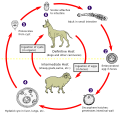चित्र:Echinococcus Life Cycle.svg
नेविगेशन पर जाएँ
खोज पर जाएँ


पूर्वावलोकन PNG का आकार SVG फ़ाइल: ६२९ × ६०० पिक्सेल अन्य resolutions: २५२ × २४० पिक्सेल | ५०४ × ४८० पिक्सेल | ८०६ × ७६८ पिक्सेल | १,०७४ × १,०२४ पिक्सेल | २,१४९ × २,०४८ पिक्सेल | १,२८० × १,२२० पिक्सेल ।
मूल फ़ाइल (SVG फ़ाईल, साधारणत: १,२८० × १,२२० पीक्सेल्स, फ़ाईलका आकार: ६४३ KB)
फ़ाइल का इतिहास
फ़ाइलका पुराना अवतरण देखने के लिये दिनांक/समय पर क्लिक करें।
| दिनांक/समय | अंगूठाकार प्रारूप | आकार | प्रयोक्ता | प्रतिक्रिया | |
|---|---|---|---|---|---|
| वर्तमान | ०१:३१, १ फ़रवरी २०२१ |  | १,२८० × १,२२० (६४३ KB) | wikimediacommons>Pixelsquid | Resized. |
फ़ाइल का उपयोग
निम्नलिखित पन्ने इस चित्र से जुडते हैं :
